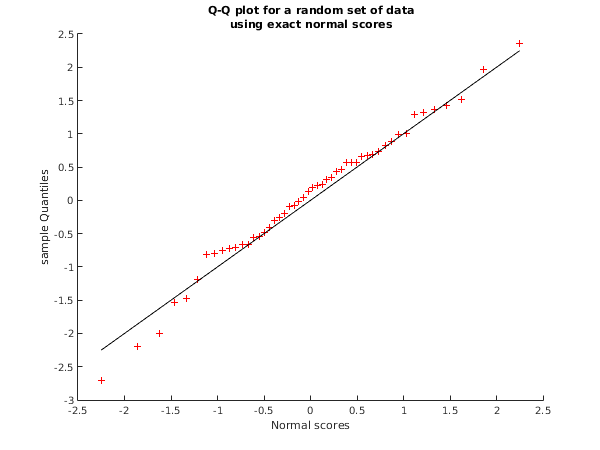PDF version (NAG web site
, 64-bit version, 64-bit version)
NAG Toolbox: nag_stat_normal_scores_exact (g01da)
Purpose
nag_stat_normal_scores_exact (g01da) computes a set of Normal scores, i.e., the expected values of an ordered set of independent observations from a Normal distribution with mean and standard deviation .
Syntax
Description
If a sample of
observations from any distribution (which may be denoted by
), is sorted into ascending order, the
th smallest value in the sample is often referred to as the
th ‘
order statistic’, sometimes denoted by
(see
Kendall and Stuart (1969)).
The order statistics therefore have the property
(If
,
is the sample median.)
For samples originating from a known distribution, the distribution of each order statistic in a sample of given size may be determined. In particular, the expected values of the order statistics may be found by integration. If the sample arises from a Normal distribution, the expected values of the order statistics are referred to as the ‘
Normal scores’. The Normal scores provide a set of reference values against which the order statistics of an actual data sample of the same size may be compared, to provide an indication of Normality for the sample
(see
nag_stat_plot_scatter_normal (g01ah)).
Normal scores have other applications; for instance, they are sometimes used as alternatives to ranks in nonparametric testing procedures.
nag_stat_normal_scores_exact (g01da) computes the
th Normal score for a given sample size
as
where
and
denotes the complete beta function.
The function attempts to evaluate the scores so that the estimated error in each score is less than the value
etol specified by you. All integrations are performed in parallel and arranged so as to give good speed and reasonable accuracy.
References
Kendall M G and Stuart A (1969) The Advanced Theory of Statistics (Volume 1) (3rd Edition) Griffin
Parameters
Compulsory Input Parameters
- 1:
– int64int32nag_int scalar
-
, the size of the set.
Constraint:
.
- 2:
– double scalar
-
The maximum value for the estimated absolute error in the computed scores.
Constraint:
.
Optional Input Parameters
None.
Output Parameters
- 1:
– double array
-
The Normal scores.
contains the value , for .
- 2:
– double scalar
-
A computed estimate of the maximum error in the computed scores (see
Accuracy).
- 3:
– int64int32nag_int scalar
unless the function detects an error (see
Error Indicators and Warnings).
Error Indicators and Warnings
Errors or warnings detected by the function:
Cases prefixed with W are classified as warnings and
do not generate an error of type NAG:error_n. See nag_issue_warnings.
-
-
-
-
- W
-
The function was unable to estimate the scores with estimated error less than
etol. The best result obtained is returned together with the associated value of
errest.
-
-
| On entry, | if n is even, ; |
| or | if n is odd, . |
-
An unexpected error has been triggered by this routine. Please
contact
NAG.
-
Your licence key may have expired or may not have been installed correctly.
-
Dynamic memory allocation failed.
Accuracy
Errors are introduced by evaluation of the functions
and errors in the numerical integration process. Errors are also introduced by the approximation of the true infinite range of integration by a finite range
but
and
are chosen so that this effect is of lower order than that of the other two factors. In order to estimate the maximum error the functions
are also integrated over the range
.
nag_stat_normal_scores_exact (g01da) returns the estimated maximum error as
Further Comments
The time taken by
nag_stat_normal_scores_exact (g01da) depends on
etol and
n. For a given value of
etol the timing varies approximately linearly with
n.
Example
The program below generates the Normal scores for samples of size , , , and prints the scores and the computed error estimates.
Open in the MATLAB editor:
g01da_example
function g01da_example
fprintf('g01da example results\n\n');
n = int64(15);
etol = 0.001;
[pp, errest, ifail] = g01da(n, etol);
fprintf('Set size = %5d\n', n);
fprintf('Error tolerance (input) = %13.3e\n', etol);
fprintf('Error estimate (output) = %13.3e\n', errest);
fprintf('Normal scores\n');
fprintf(' %10.3f%10.3f%10.3f%10.3f%10.3f\n',pp(1:n));
g01da_plot;
function g01da_plot
seed = [int64(2324213)];
genid = int64(1);
subid = int64(1);
[state, ifail] = g05kf( ...
genid, subid, seed);
n = int64(50);
[state, x, ifail] = g05sk( ...
n, 0, 1, state);
m1 = int64(1);
[x, ifail] = m01ca(x, m1, 'Ascending');
etol = 0.001;
[pp, errest, ifail] = g01da(n, etol);
fig1 = figure;
hold on
plot(pp,x,'+r',[-2.25 2.25],[-2.25 2.25],'black');
axis([-2.5 2.5 -3 2.5]);
xlabel('Normal scores');
ylabel('sample Quantiles');
title({'Q-Q plot for a random set of data','using exact normal scores'});
hold off;
g01da example results
Set size = 15
Error tolerance (input) = 1.000e-03
Error estimate (output) = 2.218e-08
Normal scores
-1.736 -1.248 -0.948 -0.715 -0.516
-0.335 -0.165 0.000 0.165 0.335
0.516 0.715 0.948 1.248 1.736
This shows a Q-Q plot for a randomly generated set of data. The normal scores have been calculated using
nag_stat_normal_scores_exact (g01da) and the sample quantiles obtained by sorting the observed data using
nag_sort_realvec_sort (m01ca). A reference line at
is also shown.
PDF version (NAG web site
, 64-bit version, 64-bit version)
© The Numerical Algorithms Group Ltd, Oxford, UK. 2009–2015
